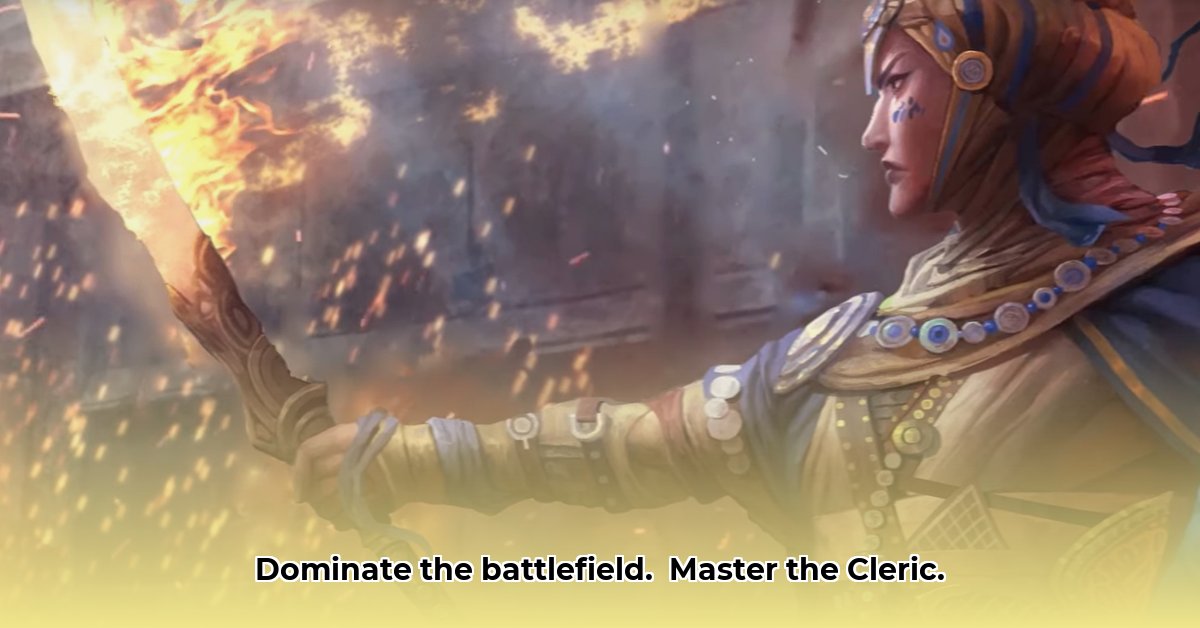Want to play a Pathfinder 2e Cleric who’s a total powerhouse? This guide is your secret weapon for divine intervention. We’ll walk through everything: picking the best god and spells, figuring out awesome character builds, and even avoiding those rookie mistakes that can really mess things up. We’ll cover the best strategies, give you the inside scoop on different Cleric types, and show you how to build a character who’ll be amazing for years of adventures. For more on character progression, check out this helpful guide on Pathfinder character advancement. Get ready to lead your party to victory!
Pathfinder Cleric: Crafting Your Divine Champion
So, you’re ready to play a cleric in Pathfinder 2e? Awesome! Clerics are incredibly versatile, capable of dishing out damage, healing allies, and generally keeping the party alive. But with so many choices, building the perfect cleric can feel overwhelming. This guide will walk you through the process, step by step, making sure you’re ready to unleash your divine power in character creation. Let’s delve into the specifics of building a compelling and effective cleric in your campaign.
Choosing Your Deity: The Guiding Light
Selecting a deity as a Pathfinder 2e Cleric isn’t just about choosing a name; it’s about aligning yourself with a source of immense power and influence. Your chosen deity shapes your spells, abilities, and even your character’s moral compass, marking your alignment. Each deity offers unique benefits, including specific spells, favored weapons, and even restrictions. For example, choosing Sarenrae, the goddess of healing and redemption, will grant you access to powerful healing spells and dictate that you act with compassion and mercy. Conversely, a cleric of Rovagug, the god of destruction, would focus on dealing damage and unleashing chaos.
| Deity | Alignment | Domains | Favored Weapon | Divine Font | Edicts | Anathema |
|---|---|---|---|---|---|---|
| Sarenrae | NG | Fire, Healing, Redemption, Sun | Scimitar | Heal | Heal the sick, show mercy | Cause needless suffering, withhold aid |
| Iomedae | LG | Duty, Glory, Might, Resolve | Longsword | Heal | Uphold justice, defend the weak | Betray trust, break oaths |
| Rovagug | CE | Destruction, Disaster, Rage, Wyrm | Greataxe | Harm | Unleash destruction, spread chaos | Show mercy, preserve order |
| Desna | CG | Dreams, Luck, Stars, Travel | Starknife | Heal | Explore the unknown, guide others | Stagnate, suppress dreams |
| Gozreh | N | Air, Animals, Change, Water | Trident | Varies | Respect nature, adapt to change | Defile nature, resist change |
| Pharasma | N | Death, Fate, Knowledge, Prophecy | Dagger | Varies | Guide souls, respect the dead | Defy fate, desecrate corpses |
| Calistria | CN | Charm, Lust, Revenge, Secrets | Whip | Varies | Pursue desires, exact retribution | Forgive slights, reveal secrets |
| Nethys | NG/NE | Magic, Protection, Scrolls, Wisdom | Staff | Varies | Seek knowledge, protect magic | Destroy knowledge, restrict magic |
Before committing, deeply consider the tenets of each deity. Does their philosophy resonate with your character’s values? Does their domain align with your preferred playstyle? This critical choice will shape your entire Pathfinder 2e experience. How will their tenets shape your character’s actions and decisions throughout the campaign?
Spell Selection: Crafting Your Divine Arsenal
Your cleric’s spells are your primary tools for interacting with the world. Selecting the right spells is critical for both combat and utility. As a cleric, you have access to two divine fonts: Heal and Harm. Choosing Heal makes you an unparalleled healer, capable of quickly restoring hit points to your allies. Harm, conversely, turns you into a potent damage dealer, inflicting necrotic damage on your foes.
Beyond your divine font, consider spells from your deity’s domains. These spells often offer unique offensive or defensive capabilities that complement your chosen deity’s themes. For example, Sarenrae offers powerful fire-based spells, while Iomedae grants access to spells that enhance your martial prowess.
When choosing spells, prioritize versatility. Select spells that can be used in a variety of situations, from healing and buffing allies to dealing damage and controlling enemies. Some essential spells for any cleric include:
- Heal/Harm: Your primary healing or damage spell.
- Bless: A powerful buff that increases your allies’ attack rolls.
- Shield: A defensive spell that protects you from harm.
- Command: A versatile spell that allows you to control enemies.
- Detect Magic: A utility spell that allows you to identify magical items and effects.
Remember that Pathfinder 2e uses a three-action system. Consider the action cost of each spell when making your selections. Lower-level spells can sometimes be more efficient than higher-level spells, especially when you need to act quickly. What combinations of spells can you use to create powerful synergies and maximize your impact on the battlefield?
Ancestries and Attributes: Shaping Your Divine Vessel
Your character’s ancestry provides a foundation for your cleric’s abilities. Each ancestry offers unique attribute boosts, feats, and abilities that can enhance your effectiveness. Certain ancestries are particularly well-suited for clerics due to their natural affinity for Wisdom or other relevant attributes.
Some of the best ancestries for clerics include:
- Human: Humans are versatile and gain an additional skill feat and general feat, allowing for customization and flexibility.
- Elf: Elves have a natural boost to Wisdom and are skilled in Perception, making them excellent spellcasters.
- Dwarf: Dwarves are hardy and gain a boost to Constitution, making them resilient in combat.
- Gnome: Gnomes have a boost to Charisma and access to illusion magic, making them adept at trickery and deception.
| Ancestry | Key Attributes | Benefits | Notable Feats |
|---|---|---|---|
| Human | Flexible | Extra skill and general feats, adaptable to any role | Natural Ambition, Clever Improviser |
| Elf | Wisdom, Dexterity | Low-light vision, skilled in perception, access to arcane magic | Elven Instincts, Ancestral Longevity |
| Dwarf | Constitution, Wisdom | Darkvision, hardy, resistant to poison | Unburdened Iron, Stonecunning |
| Gnome | Charisma, Dexterity | Low-light vision, illusion magic | Burgeoning Belief, Vivid Illusion |
| Halfling | Dexterity, Luck | Small size, nimble, lucky, resistant to fear | Second Chance, Wellspring Magic |
When choosing your ancestry, consider how its attributes and feats will complement your chosen deity, domain, and playstyle. A Warpriest cleric might benefit from the Dwarf’s Constitution boost, while a cloistered cleric might prefer the Elf’s Wisdom boost and magical aptitude. How will your choice of ancestry shape your character’s personality and interactions with the world?
Archetypes: Divergent Paths of Divinity
Pathfinder 2e offers a variety of archetypes that allow you to further customize your cleric and explore different facets of their divine calling. Archetypes provide access to new feats and abilities that can significantly alter your character’s playstyle.
Some of the most popular archetypes for clerics include:
- Warpriest: Warpriests combine divine magic with martial prowess, becoming formidable combatants.
- Champion: Champions are holy warriors who dedicate themselves to fighting evil and upholding justice.
- Medic: Medics are skilled healers who can quickly restore their allies’ hit points and remove harmful conditions.
- Loremaster: Loremasters are scholars who delve into ancient lore and uncover hidden secrets.
- Blessed One: Gain Focus spells based on Charisma, making you a potent buffer and supporter.
Each archetype offers a unique set of feats and abilities that can significantly alter your character’s playstyle. Warpriests gain access to martial weapons and armor, while Champions can smite their enemies with divine power. Medics can quickly stabilize dying allies, while Loremasters can identify magical items and uncover hidden secrets.
When choosing an archetype, consider how it will complement your chosen deity, domain, and ancestry. A Warpriest cleric of Iomedae would be a formidable holy warrior, while a Medic cleric of Sarenrae would be an unparalleled healer. How will your choice of archetype shape your character’s role in the party and their interactions with the world?
Mastering Your Role: Advanced Tactics and Strategies
Becoming a master cleric requires practice and a deep understanding of your abilities. Don’t be afraid to experiment with different spells, feats, and tactics to find what works best for you.
Key Strategies for Clerics:
- Prioritize Buffs and Debuffs: Clerics excel at enhancing their allies’ abilities and hindering their enemies. Use spells like Bless, *
- Why Does CoD Always Fail to Launch? Understanding the Core Issues - December 25, 2025
- Why Call of Duty Not Launching on Steam? Common Technical Reasons - December 24, 2025
- Call of Duty Not Launching Steam? Get Your Game Running Again - December 23, 2025





